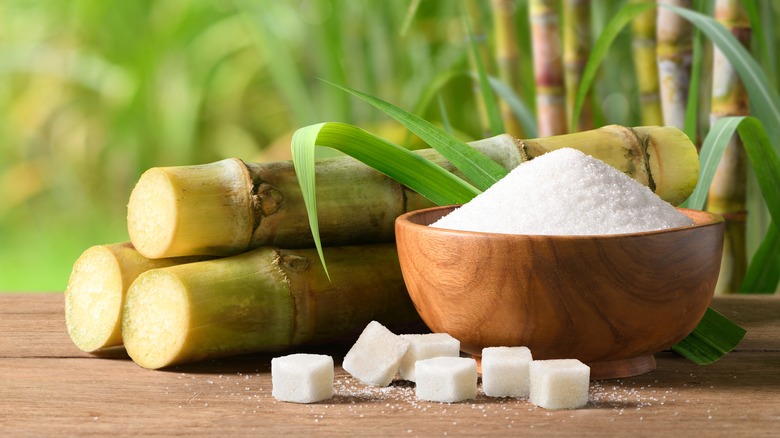Discover the Uses and Perks of Beet Sugar Vs Cane Sugar in Your Daily Diet
Checking out the distinct high qualities of beet and cane sugar reveals greater than simply their sweetening abilities; it highlights their unique influence on health and cookeries. Beet sugar, known for its refined taste, is usually favored in fragile desserts, whereas cane sugar, with its tip of molasses, adds splendor to durable meals. Each kind holds its own dietary profile and glycemic effects, welcoming a much deeper understanding of their roles in a well balanced diet plan and sustainable intake practices.
Beginning and Production Procedures of Beet and Cane Sugar

The distinctive environments and dirt types required for expanding sugar beetroots and sugarcane add to differences in their farming techniques and geographical distribution, influencing the economics and sustainability of their manufacturing. beet sugar vs cane sugar.
Nutritional Contrast In Between Beet Sugar and Cane Sugar
Regardless of stemming from different plants, beet sugar and cane sugar are nutritionally extremely comparable, both largely containing sucrose. Each offers concerning 4 calories per gram, translating to about 16 calories per teaspoon. Structurally, both sugars are composed of approximately 99.95% sucrose, with marginal quantities of other compounds like wetness and trace element, which do not dramatically modify their nutritional accounts.

Inevitably, when selecting in between beet sugar and cane sugar based on dietary web content alone, both offer identical advantages and downsides as they are basically types of the same molecule-- sucrose, providing fast energy without other nutrients.
Effect On Health: Glycemic Index and Caloric Material
Exploring even more right into the results of beet sugar and cane sugar on health and wellness, it is necessary to consider their glycemic index and caloric material. Both sugars are identified as sucrose, which includes sugar and fructose. This structure leads them to have a comparable effect on blood sugar degrees. The glycemic index (GI) of both beet and cane sugar is around 65, categorizing them as high-GI foods, which can cause fast spikes in blood sugar degrees. This is a vital facet for individuals taking care of diabetes or those trying to maintain their power levels throughout the day.
Each sort of sugar includes about 4 calories per gram, making their caloric material equivalent. For those keeping an eye on caloric intake, specifically when managing weight or metabolic health and wellness conditions, understanding this equivalence is crucial (beet sugar vs cane sugar). Too much usage of any kind of high-calorie, high-GI food can contribute to health problems such as obesity, heart illness, and insulin resistance.
Environmental and Economic Factors To Consider of Sugar Production
Beyond health effects, the manufacturing of beet and cane sugar likewise increases significant environmental and financial concerns. Sugar beet farming often tends to require cooler climates and has a lower geographical impact contrasted to sugar cane, which thrives in tropical regions. Both plants are intensive in terms of water use and land occupation, possibly leading to deforestation and water scarcity. their explanation Financially, the worldwide sugar market is extremely unstable, influenced by adjustments in worldwide trade plans and subsidies. Many countries incentivize sugar production through economic support, skewing market value and impacting small farmers adversely.
Furthermore, using chemicals and plant foods in both beet and cane sugar cultivation can cause dirt deterioration and air pollution, further impacting biodiversity and neighborhood water bodies (beet sugar vs cane sugar). The choice between growing sugar beet or cane frequently rests on local environmental conditions and financial variables, making the sustainability of sugar production an intricate problem
Culinary Applications and Flavor Differences
While the ecological and financial aspects of sugar production are certainly substantial, the option between beet and cane sugar additionally affects cooking applications and flavor profiles. Beet sugar, obtained from the sugar beet plant, is recognized for its remarkably neutral taste. This makes it a versatile component in baking, where it does not modify the taste of other components. It dissolves promptly and is excellent for use in cakes, cookies, and breads.
Walking cane sugar, extracted from sugarcane, commonly maintains molasses traces, which give more info here a distinctive richness and deepness. This small molasses taste enhances the intricacy of baked items, sauces, and sauces. It is specifically preferred in items where a sugar undertone is preferred, such as in brownies or gingerbread. Moreover, site web the mild variation in dampness material between beet and cane sugar can affect the appearance and uniformity of recipes, making cane sugar a recommended option for details recipes that profit from its one-of-a-kind residential properties.

Conclusion
Finally, both beet and cane sugar have distinctive beginnings and manufacturing procedures, offering comparable dietary accounts with minor differences in sodium material and flavor. While their impact on wellness, particularly pertaining to glycemic index and calories, is equivalent, the selection between them frequently steams down to ecological, financial elements, and details culinary demands. Comprehending these facets can lead consumers in making educated decisions that align with their health and wellness goals and taste preferences.